Section 1: Agency overview and resources
1.1 Strategic direction
The Australian Securities and Investments Commission (ASIC) is an independent government body established under the Australian Securities and Investments Commission Act 2001.
ASIC's objectives, as set out in the Australian Securities and Investments Commission Act 2001 are to:
- maintain, facilitate and improve the performance of the financial system and the entities within that system in the interests of commercial certainty, reducing business costs, and the efficiency and development of the economy;
- promote the confident and informed participation of investors and consumers in the financial system;
- administer the laws that confer functions and powers on it effectively and with a minimum of procedural requirements;
- receive, process and store, efficiently and quickly, the information given to ASIC under the laws that confer functions and powers on it;
- ensure that information is available as soon as practicable for access by the public; and
- take whatever action it can take, and is necessary, in order to enforce and give effect to the laws of the Commonwealth that confer functions and powers on it.
ASIC's areas of regulatory responsibility include consumer protection and market integrity in the financial services sector, investment management (including superannuation), capital markets (including primary and secondary capital markets), credit and corporations and their auditors and liquidators.
ASIC also operates a major public register function that provides information about Australia's 1.7 million companies, financial services licensees and other professionals registered with ASIC.
ASIC also provides public and consumer education material through a variety of community outreach activities and programs, and has an enforcement and regulatory role designed to deal with misconduct, in order to promote a confident and informed market.
In 2011-12 ASIC will be implementing a number of the Stronger Super reforms, including the development of a register for self managed superannuation fund auditors.
ASIC will put in place a regulatory framework and revise its supervisory systems and processes for the introduction of market competition. This builds on the earlier transfer of market supervision responsibilities from the Australian Securities Exchange to ASIC in August 2010.
In addition, ASIC will receive funding of $28.8m in 2011-12 for the continuation of the global financial crisis program and to sustain operations until the completion of the Government's review into ASIC's funding, expected in the first half of the financial year.
ASIC expects to have an average staffing level of 1,885 in 2011-12, with offices in all states and territories.
ASIC will continue to focus on the following priorities:
- financial economy priorities; and
- building confidence in the integrity of Australia's capital markets;
- assisting and protecting retail investors and consumers in the financial economy;
- facilitating international capital flows and international enforcement; and
- continuing to manage the domestic and international implications of the global financial crisis; and
- real economy priorities;
- lifting operational effectiveness and service levels for all ASIC stakeholders; and
- using new technologies to improve services and reduce costs.
1.2 Agency resource statement
Table 1.1 shows the total resources from all sources. The table summarises how resources will be applied by outcome and by administered and departmental classification.
Table 1.1: Australian Securities and Investments Commission resource statement — Budget
estimates for 2011-12 as at Budget May 2011
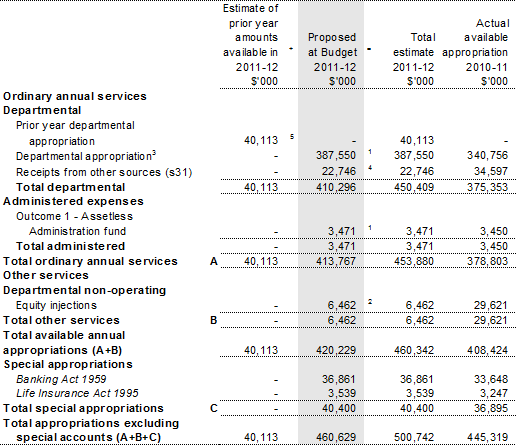
Table 1.1: Australian Securities and Investments Commission resource statement — Budget
estimates for 2011-12 as at Budget May 2011 (continued)
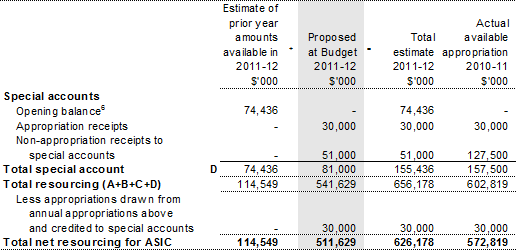
1. Appropriation Bill (No. 1) 2011-12.
2. Appropriation Bill (No. 2) 2011-12.
3. Includes an amount of $58.6 million in 2011-12 for the departmental capital budget (refer to Table 3.2.5 for further details).
4. Receipts received under s31 of the Financial Management and Accountability Act 1997.
5. Estimated adjusted balance carried from previous year for annual appropriations.
6. Estimated opening balance for special accounts (refer to Table 3.1.2 for further details).
1.3 Budget measures
Budget measures relating to ASIC are detailed in Budget Paper No. 2, Budget Measures 2011-12 and are summarised below.
Table 1.2: Australian Securities and Investments Commission 2011-12 Budget measures
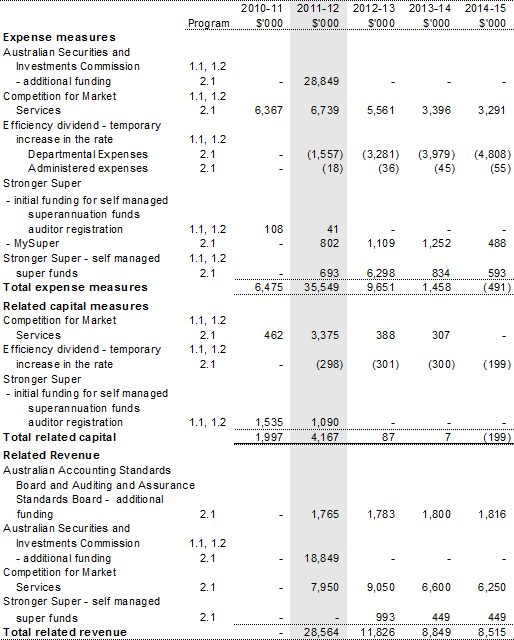
Prepared on a government finance statistics (fiscal) basis.
Section 2: Outcomes and planned performance
2.1 Outcomes and performance information
Government outcomes are the intended results, impacts or consequences of actions by the Government on the Australian community. Commonwealth programs are the primary vehicle by which government agencies achieve the intended results of their outcome statements. Agencies are required to identify the programs which contribute to Government outcomes over the budget and forward years.
ASIC's outcome is described below, specifying the strategy, program, objective, deliverables and key performance indicators used to assess and monitor the performance of ASIC.
Outcome 1: Improved confidence in financial market integrity and protection of investors and consumers through research, policy, education, compliance and deterrence that mitigates emerging risks
Outcome 1 strategy
The strategy under Outcome 1 focuses on:
- building confidence in the integrity of Australia's capital markets;
- assisting and protecting retail investors and consumers in the financial economy; and
- continuing to manage the implications of the global financial crisis.
Outcome expense statement
Table 2.1 provides an overview of the total resources for Outcome 1.
Table 2.1: Budgeted expenses for Outcome 1
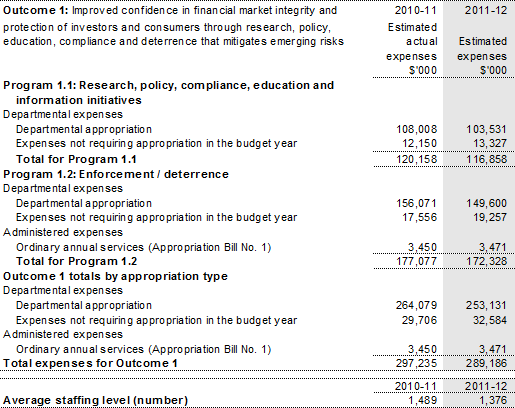
Contributions to Outcome 1
Program 1.1: Research, policy, compliance, education and information initiatives
Program 1.1 objective
Program 1.1 contributes to Outcome 1 by improving industry behaviour where market integrity and consumer confidence are most at risk, and by helping consumers and retail investors make well informed decisions in the financial economy.
Program 1.1 expenses
There are no significant changes to estimates across the forward years.
Table 2.2: Program 1.1 expenses

Program 1.1 deliverables
Improving industry behaviour
Financial economy programs, for each major grouping of market participants, are designed to:
- monitor market deve
lopments and identify and prioritise factors and behaviours most likely to result in threats to market integrity and the fair treatment of consumers; - devise and implement information, guidance and regulatory initiatives most likely to reduce the threat of misconduct or mistreatment of consumers and retail investors; and
- target misconduct or mistreatment through tailored deterrence activity.
Helping retail investors and consumers
Retail investor and consumer programs are designed to:
- give consumers and retail investors access to clear, useful information about financial economy products and services;
- make financial advice more accessible and more reliable;
- enhance community-wide financial literacy; and
- enable consumers and retail investors to better assess the benefits and risks of decisions about financial products and services.
Program 1.1 key performance indicators
ASIC has the following key performance indicators:
- improved confidence in market integrity;
- improvements in quality and availability of financial advice;
- improvements in overall financial literacy levels;
- improvements in retail investor and consumer perception of information received about products and services; and
- improvements in conduct of market participants and corporates.
Program 1.2: Enforcement / deterrence
Program 1.2 objective
Program 1.2 contributes to Outcome 1 by enforcing the law to maximise deterrent effect and improve behaviour of entities subject to the laws that ASIC administers.
Program 1.2 expenses
There are no significant changes to estimates across the forward years.
Table 2.3: Program 1.2 expenses

Program 1.2 deliverables
Enforcement / deterrence
Deterrence programs are designed to:
- investigate suspect conduct and take appropriate and timely criminal, civil or administrative action, especially where market integrity and consumers and retail investors are most at risk;
- create community confidence that the law is being effectively enforced;
- communicate clearly about ASIC's enforcement approach and outcomes to improve industry understanding and drive behavioural change in key risk areas; and
- encourage industry participation in enhanced standards of behaviour (alleviating the need for additional regulation).
ASIC finances preliminary investigations and reports by liquidators into the failure of companies with little or no assets that have been selected by ASIC, where it appears that enforcement action may result from the investigation and report. A particular focus of the Assetless Administration Fund is to curb fraudulent phoenix activity.
Program 1.2 key performance indicators
ASIC has the following key performance indicators:
- clear alignment between ASIC enforcement actions and key risk areas; and
- improved stakeholder perceptions of how ASIC deals with people who do not comply with the law.
Outcome 2: Streamlined and cost-effective interaction and access to information for business and the public, through registry, licensing and business facilitation services
Outcome 2 Strategy
The strategy under Outcome 2 focuses on:
- lifting ASIC's operational effectiveness and service levels for all stakeholders;
- using technology to reduce costs for business and contribute to cutting red tape; and
- facilitating business, including international capital flows.
Outcome 2 budgeted expenses
Table 2.4 provides an overview of the total resources for Outcome 2 by program.
Table 2.4: Budgeted expenses for Outcome 2
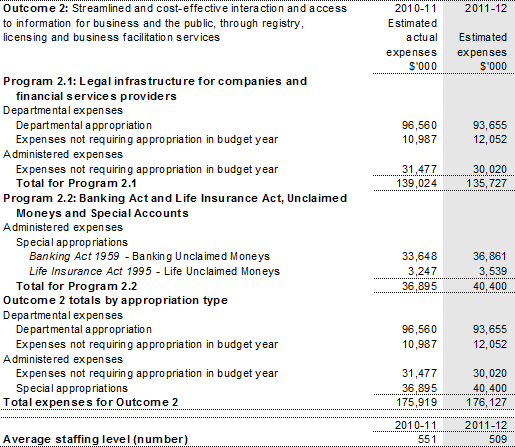
Contributions to Outcome 2
Program 2.1: Legal infrastructure for companies and financial services providers
Program 2.1 objective
Program 2.1 contributes to Outcome 2 by improving ASIC's registry and stakeholder services by developing initiatives for business and consumer stakeholders to:
- simplify their interactions with ASIC; and
- reduce the cost of those interactions.
Program 2.1 expenses
There are no significant changes to estimates across the forward years.
Table 2.5: Program 2.1 expenses

Program 2.1.1 deliverables
Modernising registry services
Programs are designed to:
- provide stakeholders with modern, efficient, accurate and cost effective corporate register and licensing systems; and
- improve public access to information about registered and licensed entities.
Improving stakeholder services
Programs are designed to:
- improve service delivery to better meet stakeholder needs;
- take prompt and appropriate regulatory action on reports of misconduct;
- provide accurate information and assistance to the public; and
- provide accurate and useful information to industry stakeholders about the regulatory system and ASIC's administration of it.
Facilitating business
Initiatives are designed to:
- reduce costs and red tape for businesses by making it easier to transact with ASIC;
- improve consultation with regulated entities and other stakeholders;
- administer the law to enhance commercial certainty and reduce business costs; and
- facilitate inward and outward investment in Australian capital markets.
Program 2.1 key performance indicators
ASIC has the following key performance indicators:
- improved effectiveness and efficiency of registry and licensing services;
- improved stakeholder satisfaction with ASIC's corporate register and other stakeholder services; and
- ASIC's regulatory system not being seen as a major barrier to inward and outward capital flows.
Program 2.2: Banking Act and Life Insurance Act, unclaimed moneys and special accounts
Program 2.2 objectives
ASIC is responsible for the administration of unclaimed moneys from banking and deposit taking institutions, and life insurance institutions.
Moneys from bank and deposit taking institutions that are inactive for seven or more years are transferred to the Commonwealth and deposited into the Official Public Account (OPA).
Moneys in respect of matured life insurance policies that have not been claimed within seven years are transferred to the Commonwealth and deposited into the OPA.
Refunds are paid to successful claimants out of the OPA.
Program 2.2 expenses
There are no significant changes to estimates across the forward years.
Table 2.6: Program 2.2 expenses

Program 2.2 deliverables
Provide an accurate register of unclaimed moneys and special accounts administered by ASIC.
Program 2.2 key performance indicators
ASIC has the following key performance indicators:
- ensure that refunds of unclaimed moneys are paid to successful claimants promptly; and
- ensure that payments of moneys from special accounts are paid out promptly in accordance with the specified purposes or appropriate legislation.
Section 3: Explanatory tables and budgeted financial statements
Section 3 presents explanatory tables
and budgeted financial statements which provide a comprehensive snapshot of agency finances for the budget year 2011-12. It explains how budget plans are incorporated into the financial statements and provides further details of the reconciliation between appropriations and program expenses, movements in administered funds, special accounts and government Indigenous expenditure.
3.1 Explanatory tables
3.1.1 Movement of administered funds between years
ASIC has not moved any administered funds between years.
3.1.2 Special accounts
Special accounts provide a means to set aside and record amounts used for specified purposes. Special accounts can be created by a Finance Minister's determination under the Financial Management and Accountability Act 1997 or under separate enabling legislation. Table 3.1.2 shows the expected additions (receipts) and reductions (payments) for each account used by ASIC.
Table 3.1.2: Estimates of special account cash flows and balances
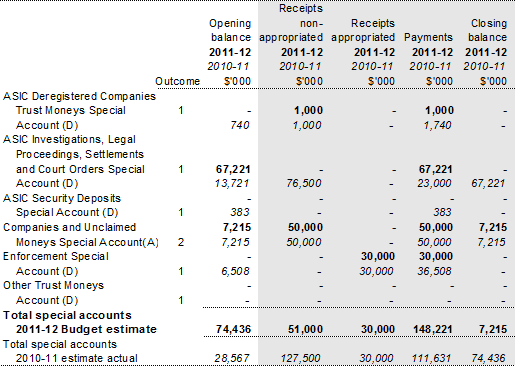
(A) = Administered.
(D) = Departmental.
3.1.3 Australian Government Indigenous Expenditure
Table 3.1.3: Australian Government Indigenous Expenditure

3.2 Budgeted financial statements
3.2.1 Differences in agency resourcing and financial statements
There are no material differences between the resource information presented in the Budget Papers and Portfolio Budget Statements as a result of differences between Australian Accounting Standards and Government Finance Statistics.
3.2.2 Analysis of budgeted financial statements
Budgeted departmental income statement
ASIC is currently budgeting for a break-even operating result for 2011-12 and for the remainder of the forward estimates, after adding back non-appropriated depreciation and amortisation expenses under the new net cash appropriation arrangements, which began in the 2010-11 Budget. The new arrangements involve the cessation of funding for depreciation, amortisation and makegood expenses. Funding for these expenses has been replaced with a departmental capital budget (Table 3.2.5 refers).
Total revenue and expenses (excluding depreciation) are estimated to be $346.8 million for 2011-12. The expenditure will be used to fund activities that contribute towards achieving the outcome and program objectives outlined in Section 2.
Budgeted departmental balance sheet
This statement shows the financial position of ASIC. It helps decision makers to track the management of ASIC's assets and liabilities.
ASIC's budgeted equity (or net asset position) for 2011-12 is $153.7 million.
The 2011-12 equity position reflects the cumulative effect of capital injections of $65.1 million received during 2011-12.
Budgeted departmental statement of cash flows
The budgeted statement of cash flows provides important information on the extent and nature of cash flows by categorising them into expected cash flows from operating activities, investing activities and financing activities.
Departmental statement of changes in equity — summary of movement
This statement shows the changes in the equity position of ASIC. It helps decision makers to track the management of ASIC's equity.
Departmental Capital Budget statement
This statement shows details of capital appropriations received by ASIC. It helps decision makers to track the acquisition of new non-financial assets.
Statement of asset movements — departmental
This statement shows details of gross asset movements during the year. It helps decision makers to analyse movements of non-financial assets.
Schedule of administered activity
Schedule of budgeted income and expenses administered on behalf of government
The schedule of budgeted income and expenses administered on behalf of government shows the revenue and expenses associated with the collection of revenue under the Corporations Act 2001 and ASIC's responsibilities in administering unclaimed moneys under the Banking Act 1959 and the Life Insurance Act 1995.
Other non-taxation revenue represents the amount of fees and charges budgeted to be levied under the Corporations Act 2001 and estimated receipts of unclaimed moneys under the Banking Act 1959 and the Life Insurance Act 1995.
Expenses represent budgeted payments of unclaimed moneys, refund of overpaid fees and charges levied under the Corporations Act 2001, bad debt expense and payments to registered insolvency practitioners to investigate breaches of directors' duties and fraudulent conduct.
Schedule of budgeted assets and liabilities administered on behalf of government
The amount shown for receivables in 2011-12 and in the forward estimates is the estimated amount of fees and charges under the Corporations Act 2001 remaining unpaid at 30 June.
The amounts shown in other payables for 2011-12 and the forward estimates represent the estimated amount of refunds relating to the overpayments of annual review and other fees under the Corporations Act 2001.
Schedule of budgeted administered cash flows
Budgeted administered cash flows provide important information on the extent and nature of cash flows by categorising them into expected cash flows from operating activities, investing activities and financing activities.
3.2.3 Budgeted financial statements tables
Table 3.2.1: Budgeted departmental comprehensive income statement
(for the period ended 30 June)
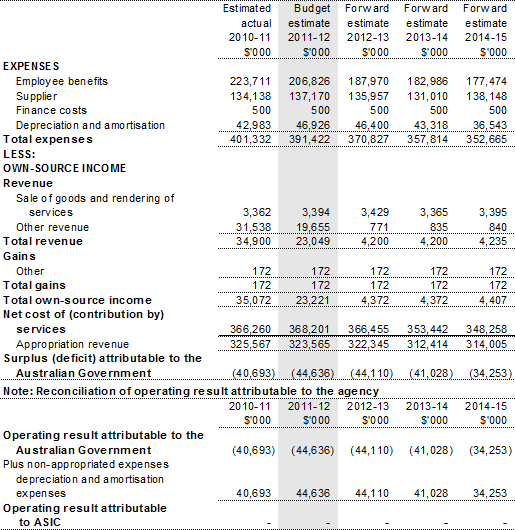
Prepared on Australian Accounting Standards basis.
Table 3.2.2: Budgeted departmental balance sheet
(as at 30 June)
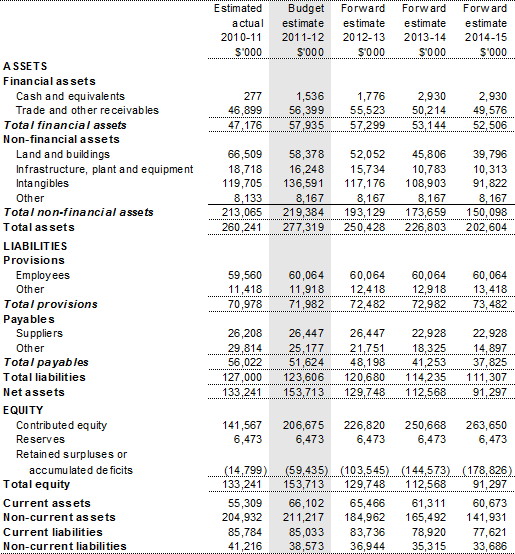
Prepared on Australian Accounting Standards basis.
Table 3.2.3: Budgeted departmental statement of cash flows
(for the period ended 30 June)
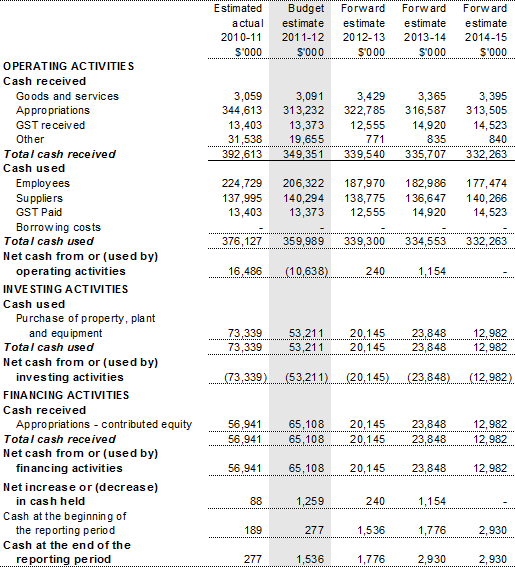
Prepared on Australian Accounting Standards basis.
Table 3.2.4: Departmental statement of changes in equity — summary of
movement (budget year 2011-12)
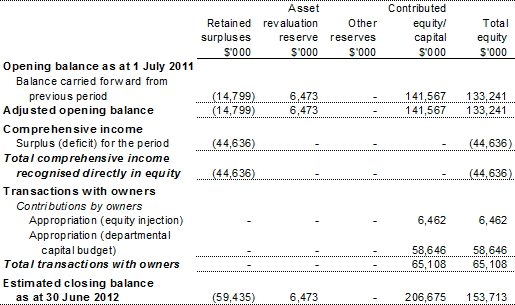
Prepared on Australian Accounting Standards basis.
Table 3.2.5: Departmental capital budget (DCB) statement
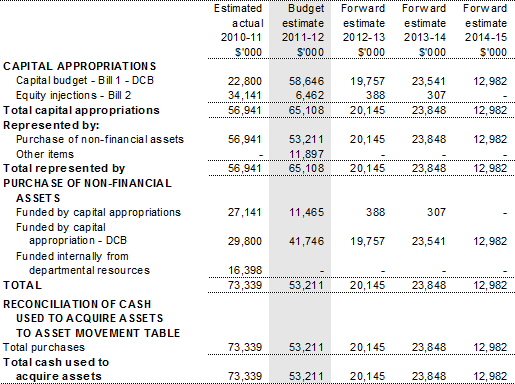
Prepared on Australian Accounting Standards basis.
Table 3.2.6: Statement of asset movements — departmental
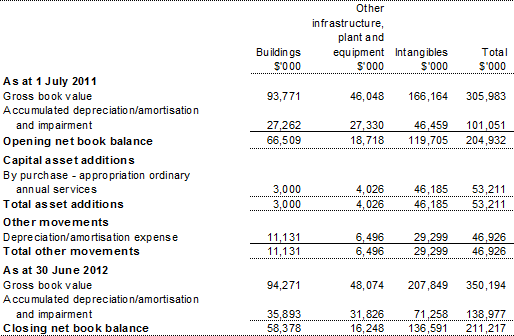
Prepared on Australian Accounting Standards basis.
Table 3.2.7: Schedule of budgeted income and expenses administered on behalf of
government (for the period ended 30 June)
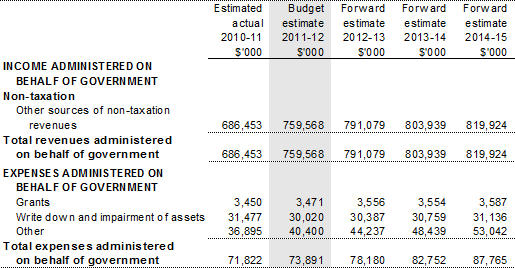
Prepared on Australian Accounting Standards basis.
Table 3.2.8: Schedule of budgeted assets and liabilities administered on behalf of
government (as at 30 June)
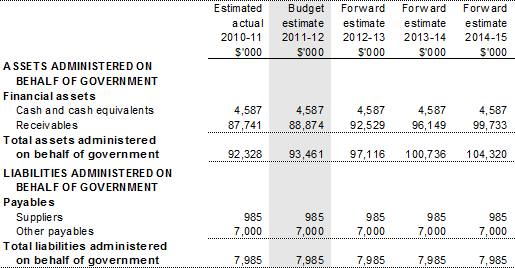
Prepared on Australian Accounting Standards basis.
Table 3.2.9: Schedule of budgeted administered cash flows
(for the period ended 30 June)
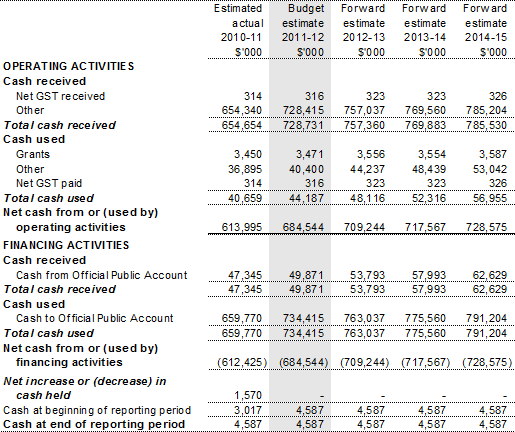
Prepared on Australian Accounting Standards basis.
3.2.4 Notes to the financial statements
Basis of accounting
The budgeted financial statements have been prepared on an Australian Accounting Standards basis.
Budgeted agency financial statements
Under the Australian Government's accrual budgeting framework, and consistent with Australian Accounting Standards, transactions that agencies control (departmental transactions) are separately budgeted for and reported on from transactions that agencies do not have control over (administered transactions). This ensures that agencies are only held fully accountable for the transactions over which they have control.
Departmental items are those assets, liabilities, revenues and expenses in relation to an agency or authority that are controlled by the agency. Departmental expenses include employee and supplier expenses and other administrative costs which are incurred by the agency in providing its goods and services.
Administered items are revenues, expenses, assets and liabilities that are managed by an agency or authority on behalf of the Australian Government according to set government directions. Administered expenses and administered revenues include fees, fines and expenses that have been earmarked for a specific purpose by the Australian Government.
Appropriations in the accrual budgeting framework
Under the Australian Government's accrual budgeting framework, separate annual appropriations are provided for:
- departmental appropriations representing the Australian Government's purchase of programs from agencies;
- departmental capital appropriations for investments by the Australian Government for either additional equity or loans in agencies;
- administered expense appropriations for the estimated administered expenses relating to an existing outcome or a new outcome; and
- administered capital appropriations for increases in administered equity through funding non-expense administered payments.
Departmental
Asset valuation
ASIC has adopted fair value as a basis for valuing its leasehold improvements and plant and equipment. Valuation is conducted with sufficient frequency to ensure that the carrying amounts of assets do not differ materially from the assets' fair values as at the reporting date.
Asset recognition threshold
Purchases of property, plant and equipment are recognised initially at cost in the balance sheet, except for purchases costing less than $2,000, which are expensed in the year of acquisition.
Leases
A distinction is made between finance leases, which effectively transfer from the lessor to the lessee substantially all the risks and benefits incidental to ownership of leased non-current assets, and operating leases, under which the lessor effectively retains substantially all such risks and benefits.
Where a non-current asset is acquired by means of a finance lease, the asset is capitalised at the lower of fair value or the present value of minimum lease payments at the inception of the lease and a liability recognised for the same amount. Leased assets are amortised over the period of the lease. Lease payments are allocated between the principal component and the interest expense.
Operating lease payments are charged to the income statement on a basis that is representative of the pattern of benefits derived from the lease assets.
Depreciation and amortisation
Computer equipment is depreciated using the declining-balance method while, for all other plant and equipment, the straight-line method of depreciation is applied. Leasehold improvements are amortised on a straight-line basis over the lesser of the estimated life of the improvements or the unexpired period of the lease. Depreciation/amortisation rates (useful lives) are reviewed at each balance date and necessary adjustments are recognised.
Receivables
A provision is raised for any doubtful debts based on a review of the collectability of all outstanding accounts as at year-end.
Bad debts are written off during the year in which they are identified.
Provisions and payables
Provisions and payables represent liabilities for miscellaneous accruals and employee benefits, including accrued salary and leave entitlements, provisions for making good leased premises and lease incentives. No provision for sick leave is required as all sick leave is non-vesting.
Administered
Schedule of budgeted revenues and expenses administered on behalf of government
Revenues
Non-taxation revenues are predominately comprised of Corporations Act 2001 fees and charges, and collections of unclaimed moneys under the Banking Act 1959 and the Life Insurance Act 1995.
Write-down and impairment of assets
Write-down and impairment of assets represents waivers and write-offs of corporations law fees.
Schedule of budgeted assets and liabilities administered on behalf of government
Financial assets
The financial assets include Corporations ACT 2001 debt invoiced and still outstanding at year-end.
Schedule of budgeted administered cash flows
All cash collected by ASIC for corporations law revenue is transferred to the Official Public Account (OPA) at the close of business each day. Cash collected for Banking Act 1959 unclaimed moneys and Life Insurance Act 1995 unclaimed moneys is transferred to the OPA when received.